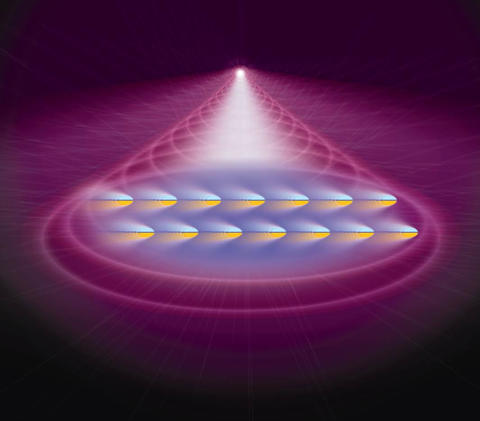
This artist's conception shows atoms in a Bose-Einstein Condensate (BEC) being pushed by laser light. When the atoms, which all have the same magnetic spin orientation (represented by their blue and yellow poles ), are pushed toward the viewer, they drift to the right because of their spin -- a result of the spin Hall effect, which has been observed in a BEC for the first time.
Researchers at the National Institute of Standards and Technology (NIST) have reported the first observation of the "spin Hall effect" in a Bose-Einstein condensate (BEC), a cloud of ultracold atoms acting as a single quantum object. As one consequence, they made the atoms, which spin like a child's top, skew to one side or the other, by an amount dependent on the spin direction. Besides offering new insight into the quantum mechanical world, they say the phenomenon is a step toward applications in "atomtronics"—the use of ultracold atoms as circuit components.
The spin Hall effect is seen in electrons and other quantum particles when their motion depends on their magnetic orientation, or "spin." Previously, the spin Hall effect has been observed in electrons confined to a two-dimensional semiconductor strip, and in photons, but never before in a BEC.
A quantum circuit might use spins, described as "up" or "down," as signals, in a way analogous to how electric charge can represent ones and zeros in conventional computers. Quantum devices however, can process information in ways that are difficult or impossible for conventional devices. Finding ways to manipulate spin is a major research effort among quantum scientists, and the team's results may help the spin Hall effect become a good tool for the job.
The team used several sets of lasers to trap rubidium atoms in a tiny cloud, about 10 micrometers on a side, inside a vacuum chamber and then cool the atoms to a few billionths of a degree above absolute zero. Under these conditions, the atoms change from an ordinary gas to an exotic state of matter called a BEC, in which the atoms all behave identically. Then, the NIST team employed another laser to gently push the BEC, allowing them to observe the spin Hall effect at work.
Spin is roughly analogous to the rotation of a top, and if the top is gently pushed straight forward, it will eventually tend to curve either to the right or left, depending on which way it is spinning. Similarly, subject to the spin Hall effect, a quantum object spinning one way will, when pushed, curve off to one side, while if it spins the other way, it will curve to the other. The BEC followed this sort of curved path after the laser pushed it.
"This effect has been observed in solids before, but in solids there are other things happening that make it difficult to distinguish what the spin Hall effect is doing," says the research team's Matthew Beeler, who just completed a postdoctoral fellowship at NIST. "The good thing about seeing it in the BEC is that we've got a simple system whose properties we can explain in just two lines of equations. It means we can disentangle the spin Hall effect from the background and explore it more easily."
Conceptually, the laser setup can be thought of as an atom spin transistor—an atomtronic device—that can manipulate spin "currents" just as a conventional electronic transistor manipulates electrical current.
Beeler says that it is unlikely to be a practical way to build a logic gate for a working quantum computer, though. For now, he says, their new window into the spin Hall effect is good for researchers, who have wanted an easier way to understand complex systems where the effect appears. It also might provide insight into how data can be represented and moved from place to place in atomtronic circuits.

